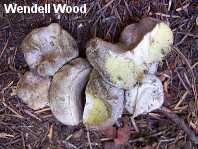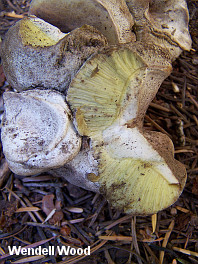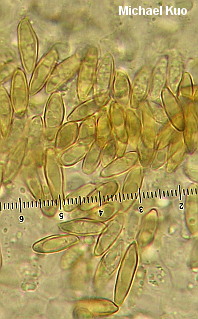| Major Groups > Boletes > Boletus subalpinus |

|
Boletus subalpinus [ Basidiomycota > Boletales > Boletinae > Boletaceae > Boletus . . . ] by Michael Kuo This funky bolete looks like a malformed, never-quite-happened member of the Boletus edulis group. Traditionally known as "Gastroboletus subalpinus," it is found in northern California and the Pacific Northwest, associating with conifers. It features an oddly oriented tube layer that has not aligned the tubes to be perpendicular to the ground (most of the tubes are curved upward by 20 degrees or more)--and, when young (or even well into maturity), the pores are covered by a whitish skin. Boletus subalpinus is distinctive among other gastroid boletes on the basis of the persistent skin covering the pores, the lack of blue bruising or staining, and the fine reticulation on the upper stem. A recent DNA study of the boletes (Nuhn and collaborators, 2013) supports the idea that "Gastroboletus subalpinus" is really a Boletus, closely related to the edulis-like species, despite its gastroid morphology. Since the edulis group is known for having pores that are "stuffed" with whitish material when young, one might argue that Boletus subalpinus fits in nicely with its new playmates. Thanks to Wendell Wood for collecting, documenting, and preserving Boletus subalpinus for study; his collection is deposited in The Herbarium of Michael Kuo. Description: Ecology: Mycorrhizal with conifers in montane and subalpine ecosystems; growing alone, scattered, or gregariously, partially or almost completely submerged; summer and fall; northern California and the Pacific Northwest. Cap: 5-10 cm across; convex, becoming broadly convex or nearly flat; dry; bald or very finely velvety; often covered with dirt and litter; often pitted; buff to tan at first, darkening to dull tan or pale brown. Tube Layer: Covered almost entirely by a thin, whitish membrane that remains whole or ruptures in some areas by maturity; tubes 1-3 cm deep, curved upwards, yellowish becoming olive brown; pores covered by the membrane, not bruising. Stem: 2-6 cm long; up to about 4 cm thick; variously shaped; bald or very finely velvety; reticulate near the apex (under the tube layer); whitish to pale tan; often covered with dirt and forest litter. Flesh: Whitish or, in places, dull yellowish; not staining when sliced, or staining slightly pinkish to purplish in the cap. Odor and Taste: Odor not distinctive; taste not distinctive, or slightly mealy. Chemical Reactions: Ammonia reddish on cap surface; orangish on flesh. KOH dark red on cap surface; orange on flesh. Iron salts greenish on cap surface; negative on flesh. Spore Print: Not obtainable. Microscopic Features: Spores 10-18 x 4.5-8 µ; smooth; subfusiform; yellowish in KOH and in Melzer's. Hymenial cystidia abundant when young but often collapsing with age; hyaline in KOH; subclavate to subfusiform; to about 75 µ long. Pileipellis a cutis; hyphae 4-15 µ wide. REFERENCES: (Trappe & Thiers, 1969) M. Nuhn, Manfr. Binder, A.F.S.Taylor, Halling & Hibbett, 2013. (Thiers & Trappe, 1969; Thiers, 1975; Arora, 1986; Both, 1993; Nouhra, Castellano & Trappe, 2002; Trappe, Evans & Trappe, 2007; Nuhn et al., 2013.) Herb. Kuo 09261206. This site contains no information about the edibility or toxicity of mushrooms. |
© MushroomExpert.Com |
|
Cite this page as: Kuo, M. (2013, December). Boletus subalpinus. Retrieved from the MushroomExpert.Com Web site: http://www.mushroomexpert.com/boletus_subalpinus.html |


